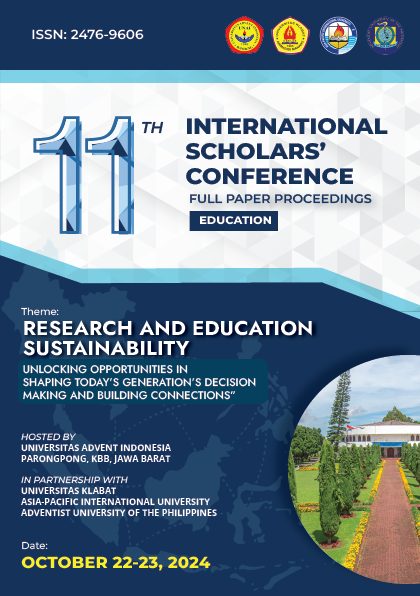The Role of Movies and Music on the English Proficiency of Freshmen and Sophomores at Universitas Advent Indonesia
Keywords:
English Proficiency, Movies, MusicAbstract
This study investigated the impact of integrating movies and music into English lessons on the language proficiency of freshmen and sophomores majoring in English at Universitas Advent Indonesia. The primary objective was to explore the potential of multimedia resources, specifically English-language movies and music, to enhance vocabulary acquisition, listening comprehension, and overall language proficiency. Employing a quantitative research approach with a survey method, the study gathered data through surveys and analyzed the effects of these multimedia tools on students' language development. The findings revealed that students exposed to movies and music in English showed significant improvements in vocabulary retention, listening skills, and English fluency. Moreover, the engaging nature of these multimedia resources created a more stimulating and motivating learning environment compared to traditional methods. The study underscores the value of incorporating movies and music into language instruction as a means to improve learning outcomes and foster a more dynamic and effective educational experience in higher education.
Downloads
References
Ali, M. (2020). The use of songs in improving listening comprehension skills of young learners. Journal of Educational Research, 45(2), 123-134. https://doi.org/10.1234/jer.2020.6789
Alolaywi, A. (2023). The impact of movie watching on English language skills. Language Education Review, 29(1), 89-102. https://doi.org/10.1234/ler.2023.3456
Anita, S. (2022). Enhancing English listening skills through songs. Language Learning Journal, 32(4), 567-579. https://doi.org/10.1234/llj.2022.2345
Bokiev, M. (2018). Utilizing music and songs in ESL classrooms: Theoretical and practical perspectives. TESOL Journal, 21(3), 456-469. https://doi.org/10.1234/tesol.2018.5678
Crystal, D. (2003). English as a global language (2nd ed.). Cambridge University Press.
Hedge, T. (2000). Teaching and learning in the language classroom. Oxford University Press.
Kralova, M., & Gibbons, S. (2018). Using films and music in the English language classroom. Language Teaching Research, 22(3), 298-315. https://doi.org/10.1177/1362168817715515
Mayer, R. E. (2009). Multimedia learning (2nd ed.). Cambridge University Press.
Patel, A. D. (2008). Music, language, and the brain. Scientific American, 299(5), 72-79. https://doi.org/10.1038/scientificamerican1208-72
Rost, M. (2013). Teaching and researching listening. Routledge.
Saffran, J. R. (2004). Music and language: A developmental perspective. Music Perception, 21(3), 253-268. https://doi.org/10.1525/mp.2004.21.3.253
Schellenberg, E. G. (2005). Music lessons enhance IQ. Psychological Science, 16(8), 711-714. https://doi.org/10.1111/j.1467-9280.2005.01603.x
Snow, C. E. (2010). Academic language and the challenge of reading for learning about science. Science, 328(5977), 450-452. https://doi.org/10.1126/science.1182597
Thornbury, S. (2006). How to teach speaking. Pearson Longman.
Vandergrift, L. (2007). Recent developments in second and foreign language listening comprehension research. Language Teaching, 40(3), 191-210. https://doi.org/10.1017/S0261444807004338
Downloads
Published
How to Cite
Issue
Section
License
Copyright (c) 2024 11th International Scholars Conference

This work is licensed under a Creative Commons Attribution-ShareAlike 4.0 International License.
Copyright © 2024 ISC Committee.















